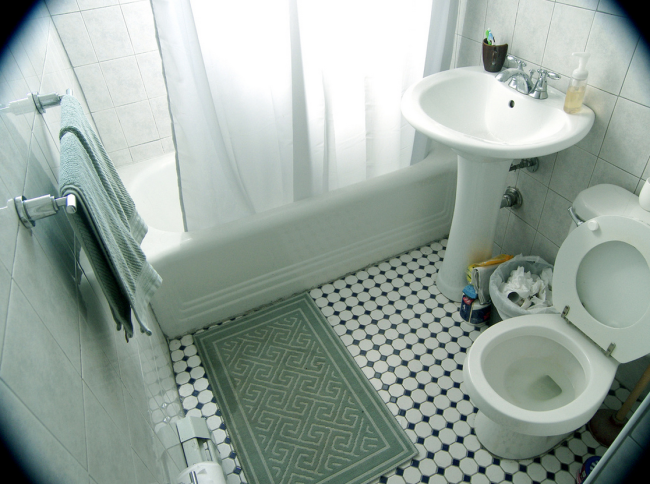A basic guide to NYC plumbing: How to keep your apartment's pipes flowing

Welcome to New York. Don't flush that.
iStock/Airquiplay77
Plumbing problems are never fun, but plumbing mishaps can be particularly unpleasant in New York City, where tight quarters mean your problems become your neighbors' problems or vice versa. And being home all the time these days means New Yorkers are experiencing more plumbing problems than usual.
In fact, two of us at Brick had to call plumbers on the very same day. These professionals told us they are seeing more drain issues in the pandemic—especially involving toilets.
That's because all this time spent at home is hard on our old pipes. One culprit: More people are using disinfectant wipes to clean and sanitize surfaces—and then flushing them down pipes that aren't up to the task. (None of our family members will fess up to this but let's just say all wipes have been put out of reach.)
One of the best ways to avoid plumbing problems in New York is to take proactive steps to make sure they don't happen in the first place. Read on for a basic guide to understanding NYC plumbing, and how to keep things flowing smoothly.
[Editor's note: A previous version of this post was published in April 2019. We are presenting it again with updated information for March 2021.]
Pipe problems, part one
New York City’s pipes are probably the biggest culprit for its plumbing woes. For one, the city is old, which means old buildings, which means old pipes.
“That can pose an issue,” says Paul Campanelli of Kapnag Heating & Plumbing, who notes that in the first half of the last century, particularly during World War II, cheaper brass was used in construction to conserve the metal, resulting in weaker pipes. (Buildings started making the switch to copper pipes in the '60s.)
Working with and doing repairs on these pipes can get dicey. “There are pipes so old that if you’ve got to snake them you can poke a hole through the pipe,” says Jeff Streich of Prime Renovations.
That said, just because your building is old doesn’t mean the specific pipes serving your apartment are old. If there’s been a renovation in a unit, “95 percent of buildings make you [upgrade] the branch lines back to risers,” Streich says.
That’s sort of good news. But it also means there could be apartments in your building with pipes that haven’t been upgraded, which means if someone in your building has an issue due to their old plumbing, it might affect you.
Want to get a comprehensive report on the potential issues with a building before you rent or buy it? Run the address through the Brick Report and get a real estate background check built from all of New York City's Open Data in one place. Brought to you by Brick Underground.
Pipe problems, part two
And while new buildings will feature copper pipes, that’s still somewhat problematic, as metal degrades over time—unlike plastic, or PVC. (Another bonus using PVC? It’s cheaper.)
“Most pipes in the city are metal,” says Taerra Pence of The Practical Diva. “And metal corrodes very, very badly. The pipe itself begins to deteriorate, it develops rough edges and begins to catch things.”
Why NYC pipes clog
In addition to corrosion, old pipes in buildings can trap a build-up of “sludge and scaling” developed over time, making clogs and problems all the more likely. (Which is why garbage disposals, while perhaps enticing, can be risky, and are often banned from buildings.)
With New York City pipes already predisposed to clogging, it’s best to be very careful about what you put in them.
Tips for keeping your pipes free and clear include:
- Use a single-ply toilet paper. (A Roto-Rooter professional recommended Scott or Marcal to us. That was it.)
- Toss products declared “flushable” in the garbage. (One plumber told us, “There’s no such thing as a 'flushable wipe.'”)
- Do the same with feminine hygiene products
- Resist the temptation to use the toilet as a “garbage can” when cleaning out the fridge. Just don't do this.
- Be aware that non-soluble elements of body scrubs and other beauty products may collect in the bend of a pipe. (True story: It took about two weeks of using an apricot body scrub—which is like gravel—to clog the pipes in a NYC rental. This was the late '90s when we didn't know any better.)
- For small clogs—like hair in bathroom sink drain—try one of these plastic snakes for under $6.
- Plumbers told us not to use Draino to unclog a drain—it is too harsh and will weaken your pipes—get one of these snakes instead—or call a professional.
And be sure to follow Campanelli’s clear advice: “Toilets are for “number one," “number two,” and toilet paper. That’s it.” (For even more recommendations on responsible disposal, head to New York City's web page dedicated to education about, and eradication of "fatbergs."
You Might Also Like


























